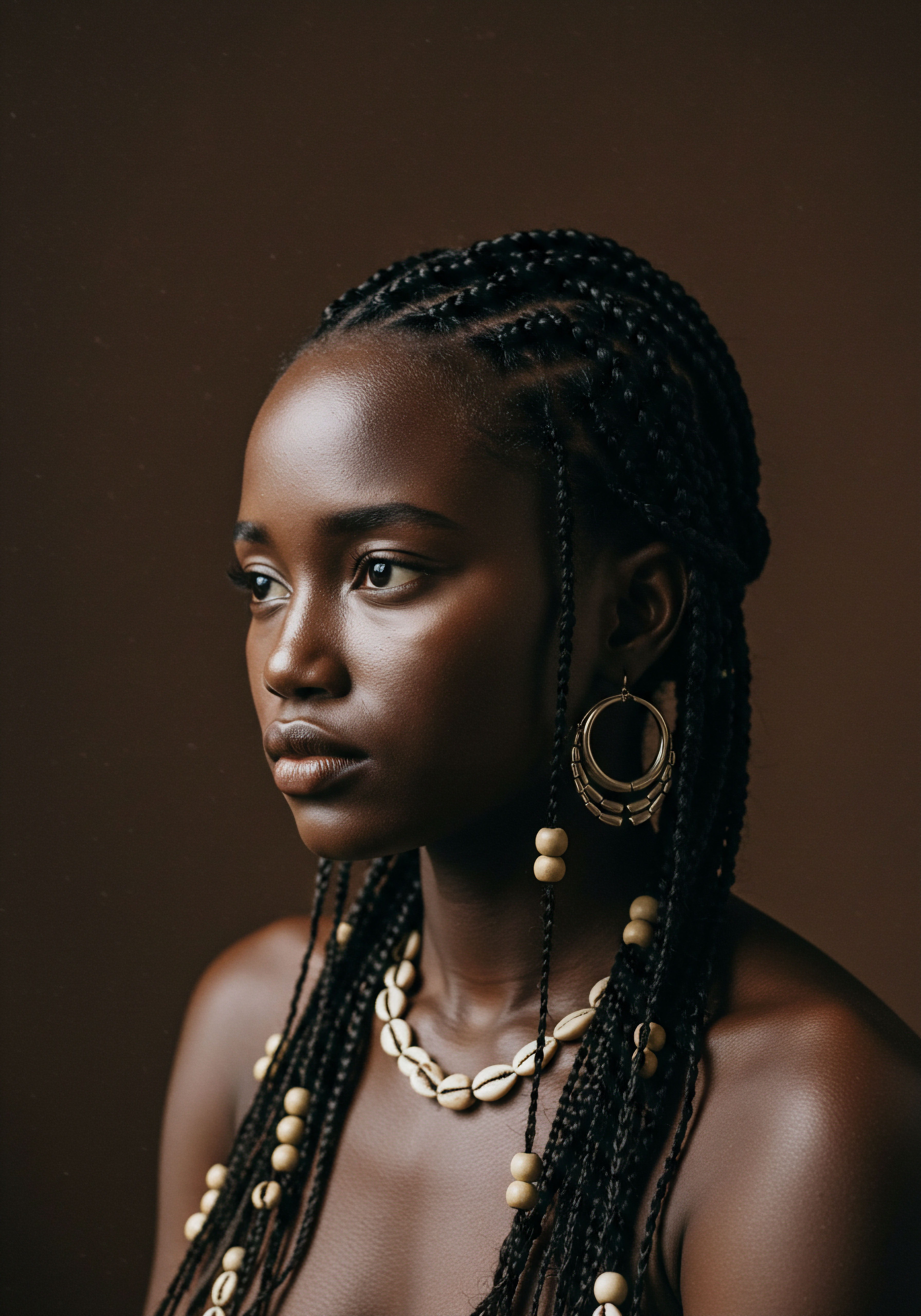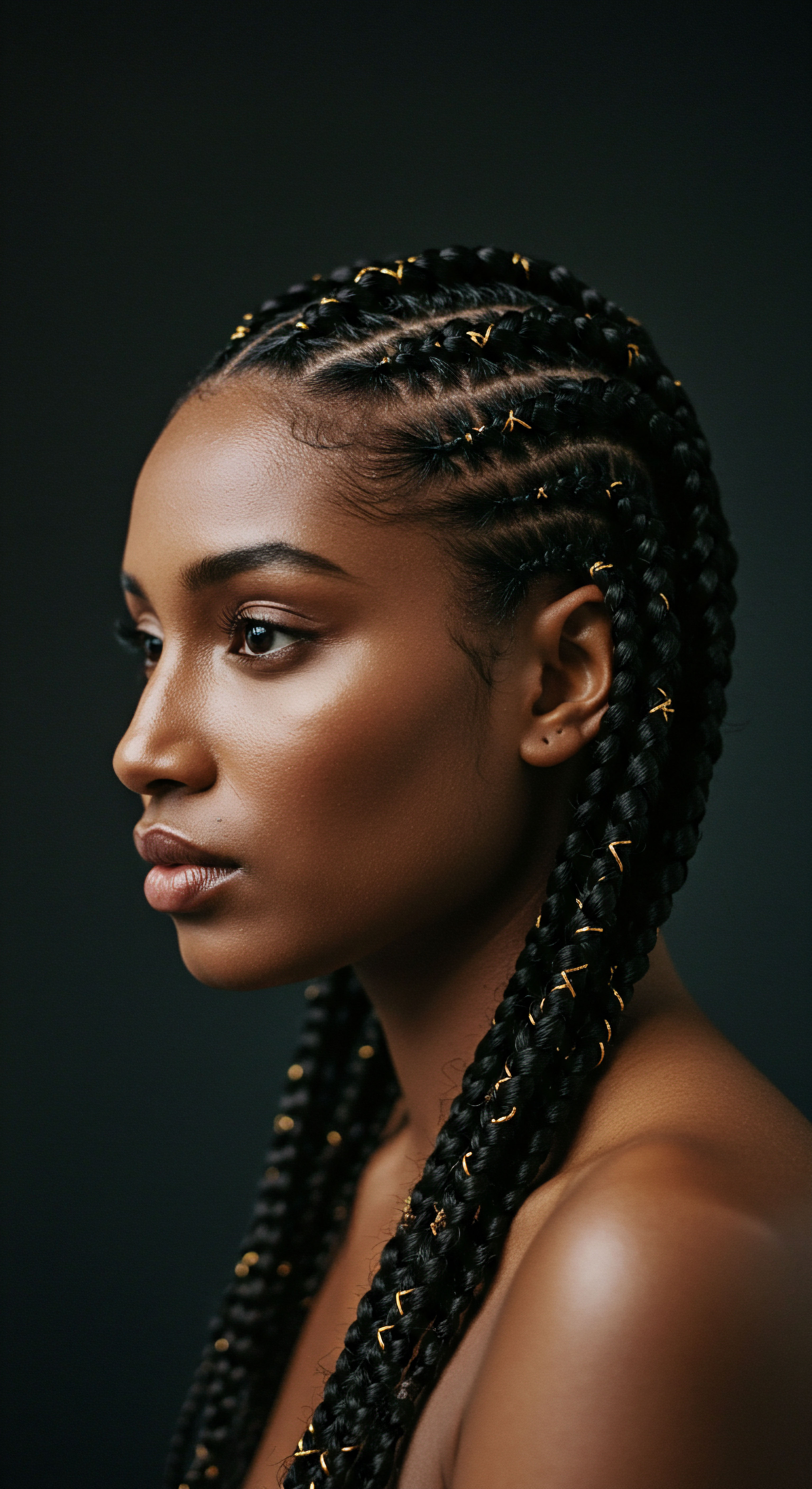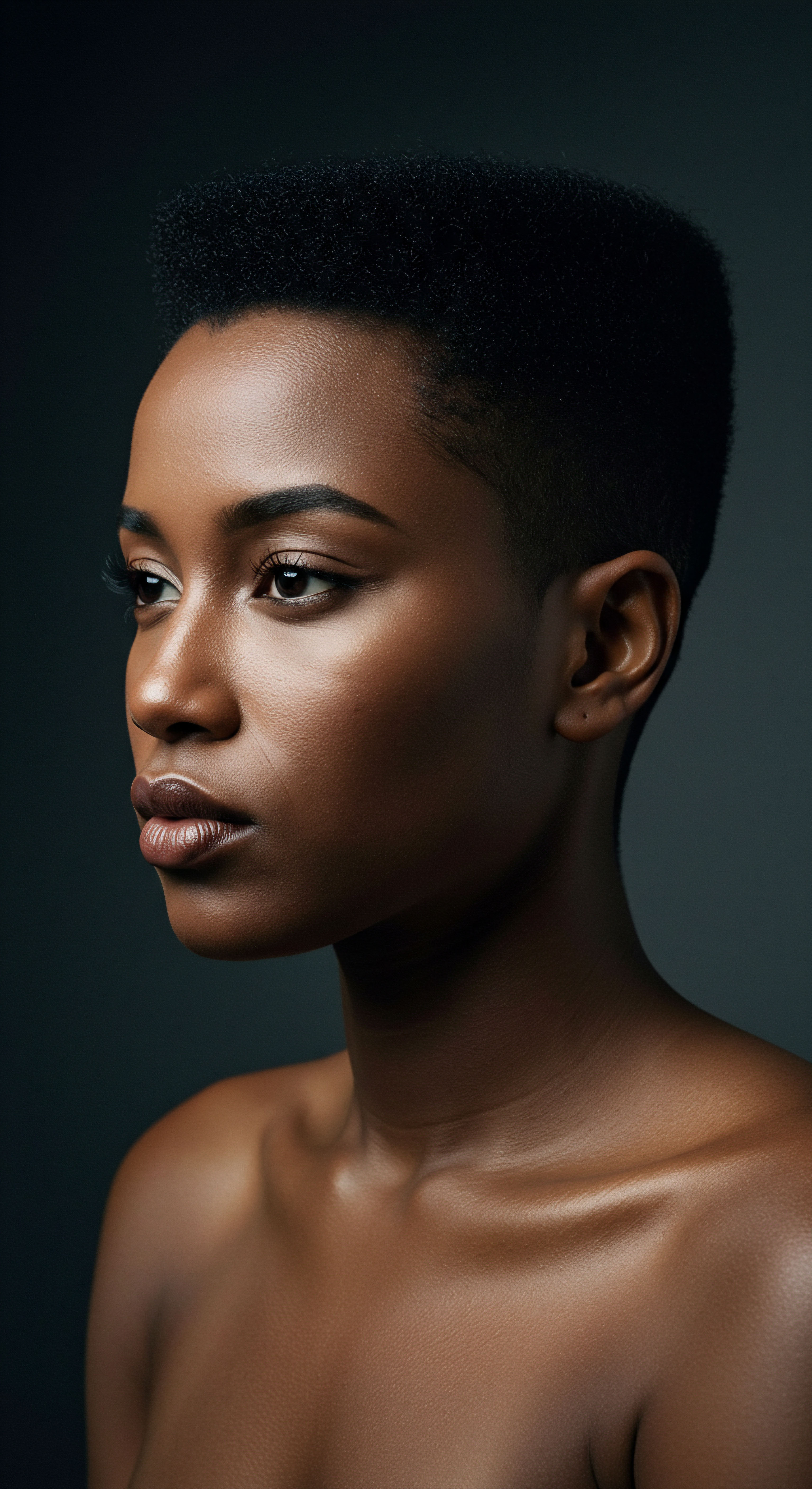
Fundamentals
Imagine a gentle rain falling upon fertile ground, meant to nourish and sustain life. Our scalp, much like this earth, possesses a delicate balance, a unique ecosystem designed to foster vibrant hair. Seborrheic Dermatitis, often referred to as SD, introduces a disruption to this natural rhythm. It is a common skin condition, an inflammatory response that primarily affects areas of the body rich in sebaceous glands—those tiny oil factories nestled beneath our skin.
Think of your scalp, your face, particularly around the nose and eyebrows, or even your chest; these are the favored landscapes where SD tends to express its presence. This condition can manifest as flaky patches, sometimes appearing greasy, accompanied by varying degrees of redness and a persistent itch. For many, the most recognizable sign on the scalp is persistent dandruff, a shower of white or yellowish flakes that can feel both frustrating and isolating.
The basic meaning of Seborrheic Dermatitis points to an overactivity or an unusual response within these oil-producing zones. While the exact trigger remains a subject of ongoing scientific inquiry, a key player in this dermal drama is a yeast-like microorganism called Malassezia. This organism naturally resides on our skin, a quiet tenant in our epidermal home.
However, when conditions allow for its excessive proliferation, perhaps fueled by an abundance of sebum, it can incite an inflammatory cascade, leading to the familiar signs of SD. This imbalance can cause discomfort, making daily life a bit more challenging for those experiencing it.
For individuals with textured hair, particularly within Black and mixed-race communities, the narrative surrounding Seborrheic Dermatitis takes on additional layers of complexity and significance. The unique structural properties of coily and curly strands, which can sometimes impede the natural movement of scalp oils down the hair shaft, may contribute to oil buildup at the scalp. This phenomenon, coupled with traditional hair care practices that might involve less frequent washing or the generous application of certain oils directly to the scalp, can inadvertently create an environment where Malassezia thrives. Understanding this interplay is paramount for holistic hair wellness.
Seborrheic Dermatitis, at its core, is a common inflammatory skin condition often linked to an overgrowth of natural yeast on oil-rich areas, notably the scalp.

Initial Manifestations on Textured Hair
The initial presentation of Seborrheic Dermatitis on textured hair can sometimes differ from common descriptions often based on lighter skin tones. While a general depiction might include red, scaly patches, individuals with darker skin complexions may observe variations. This can involve patches of Hypopigmentation, where the affected skin appears lighter than the surrounding areas, or even curved, petal-shaped lesions along the hairline. These visual distinctions highlight the importance of culturally competent dermatological assessment, ensuring accurate recognition and timely support.
- Dandruff ❉ Often the most apparent symptom, characterized by white or yellowish flakes on the scalp and hair.
- Itchiness ❉ A pervasive sensation on the scalp, which can range from mild irritation to intense discomfort.
- Greasy Patches ❉ Areas of the scalp or skin that feel oily and may be covered with scales.
- Skin Discoloration ❉ On darker skin, this might present as lighter patches (hypopigmentation) or, less commonly, darker patches (hyperpigmentation), along with a subtle pinkish or purplish hue that can be harder to discern than overt redness.
- Petaloid Lesions ❉ Distinctive curved or ring-shaped patches, particularly noticeable along the hairline or on the face, a unique expression of the condition in some skin types.

Understanding the Role of Sebum
Sebum, the natural oil produced by our sebaceous glands, plays a dual role in hair health. It provides a protective coating, offering moisture and a healthy sheen to our strands. Yet, an overproduction of this oily substance can create an environment conducive to the proliferation of Malassezia yeast, a significant factor in Seborrheic Dermatitis. The way sebum travels down the hair shaft is influenced by hair texture.
For those with tightly coiled or kinky hair, the helical structure of the strands can hinder the smooth distribution of sebum from the scalp to the ends. This can result in drier hair lengths and ends, paradoxically combined with an oily scalp, a condition that might be mistaken for simple dryness.
This dynamic underscores a deeper meaning of Seborrheic Dermatitis for textured hair communities ❉ it is not merely a surface-level irritation, but a complex interplay between natural physiology, environmental factors, and traditional care practices. Recognizing this multifaceted nature is the first step toward effective management and fostering scalp serenity.

Intermediate
Moving beyond the foundational explanation, Seborrheic Dermatitis reveals itself as a chronic, often relapsing, condition, one that calls for an ongoing dialogue between understanding and gentle intervention. The practical application of this understanding involves discerning how SD weaves itself into the fabric of daily hair care rituals, particularly for those tending to textured strands. It’s a condition that doesn’t just appear; it evolves, often influenced by the very routines meant to preserve hair health.
The meaning of Seborrheic Dermatitis at this level extends to its common contexts and how it can subtly, or sometimes overtly, influence styling choices and product preferences. For individuals with Black or mixed hair, the symptoms of SD can be particularly disruptive. The characteristic flaking can settle visibly on dark clothing, causing self-consciousness. The persistent itch might compel scratching, which, on delicate textured hair, can lead to breakage or even temporary hair thinning.

Hair Washing Frequency and Product Choices
A key aspect of managing Seborrheic Dermatitis, as often advised, involves regular cleansing of the scalp to reduce oil and yeast buildup. However, this recommendation frequently clashes with the realities of textured hair care. Many individuals with tightly coiled hair wash their hair less frequently than those with straighter textures to preserve moisture and avoid excessive dryness or breakage.
A study highlighted this disparity, finding that Black women with natural, non-traction hairstyles washed their hair on average every 14 days, while those with braid or weave styles extended this to 18 to 32 days. This data point underscores a significant challenge ❉ standard advice for SD treatment, such as using medicated shampoos several times a week, can be impractical and potentially damaging for textured hair, leading to poor adherence and persistent symptoms.
The choice of products also carries considerable weight. Traditional practices within Black communities often involve the application of natural oils like coconut, olive, or shea butter directly to the scalp, believing these promote scalp health and hair growth. While beneficial for the hair shaft itself, applying these lipid-rich oils to the scalp can inadvertently provide additional sustenance for Malassezia yeast, potentially exacerbating SD symptoms. This intricate relationship between cultural practice and dermatological outcomes necessitates a nuanced approach, one that honors heritage while adapting for scalp well-being.
Managing Seborrheic Dermatitis in textured hair demands a tailored approach, respecting traditional practices while adapting cleansing and product routines for scalp health.

Misinterpretations and Diagnostic Delays
The visual presentation of Seborrheic Dermatitis on darker skin can lead to misinterpretations and diagnostic delays. What might appear as redness on lighter skin can manifest as hypopigmentation—a lightening of the skin—or a subtle purplish or grayish discoloration on Black or brown skin. These differences, coupled with less research and training focused on skin of color within dermatology, can create diagnostic inequalities.
Patients may be misdiagnosed with simple dryness or other conditions, leading to ineffective treatments and prolonged discomfort. This calls for a deeper understanding of the condition’s diverse expressions across all skin tones.
Consider the subtle nuances ❉
- Color Variation ❉ Instead of vivid red, patches might show as lighter, grayish, or purplish tones.
- Lesion Shape ❉ The presence of petal-shaped or curved lesions, especially around the hairline, is a distinct presentation in darker skin.
- “Dry Scalp” Confusion ❉ The limited movement of natural scalp oils down tightly coiled strands can cause dryness along the hair length, making it easy to misattribute scalp flaking to simple dryness rather than SD.

Impact on Hair Health and Styling
Beyond discomfort, Seborrheic Dermatitis can influence the very health and styling of textured hair. Persistent inflammation and scratching can weaken hair follicles, potentially leading to hair loss or thinning, though typically temporary. Furthermore, the greasy scales can interfere with styling, making hair feel heavy, dull, or difficult to manage. Certain protective styles, while beneficial for hair length retention, can sometimes impede proper scalp cleansing, creating an environment where SD symptoms may worsen.
The significance of addressing SD in this context extends to preserving not only scalp health but also the aesthetic and cultural expressions tied to textured hair. It highlights the necessity of treatments that are effective without compromising hair integrity or forcing a departure from cherished styling practices.

Advanced
At an advanced level, the explication of Seborrheic Dermatitis transcends surface-level symptoms, delving into its complex pathophysiological underpinnings and its profound implications for textured hair. This chronic inflammatory dermatosis, characterized by erythema, scaling, and pruritus in sebaceous gland-rich areas, is a testament to the intricate balance of the skin’s microbiome and immune response. Its meaning here is not merely descriptive but analytical, revealing a condition whose management requires a sophisticated understanding of biological predispositions, environmental triggers, and the often-overlooked socio-cultural dimensions of hair care.
The core designation of Seborrheic Dermatitis as a common dermatological concern affecting approximately 3-5% of the global population, yet with a reported higher incidence of 6.5% among African Americans, necessitates a deeper examination of its specific manifestations and treatment challenges within this demographic. This disparity is not incidental; it prompts a rigorous inquiry into the interplay of genetic predispositions, unique hair structural characteristics, and deeply rooted cultural hair care traditions.
Seborrheic Dermatitis presents a unique dermatological challenge within textured hair communities, requiring culturally sensitive and scientifically informed interventions.

Pathophysiological Complexities and Malassezia’s Role
The pathophysiology of Seborrheic Dermatitis, while not entirely elucidated, points to a dysregulated host immune response to commensal Malassezia Species, particularly Malassezia globosa and Malassezia furfur, residing on the skin. These lipophilic yeasts thrive on sebum, metabolizing triglycerides into unsaturated fatty acids that can irritate the skin and provoke an inflammatory cascade. In individuals with tightly coiled hair, the inherent architecture of the hair shaft can impede the natural flow of sebum down the strand, leading to an accumulation of lipids on the scalp. This localized abundance of sebum creates an ideal microenvironment for Malassezia proliferation, potentially intensifying the inflammatory response.
Furthermore, the skin barrier function in affected areas may be compromised, allowing for increased transepidermal water loss and heightened susceptibility to external irritants. The cyclical nature of SD, with its seasonal flares (often worsening in colder, drier months) and exacerbation by stress, speaks to the multifaceted influences on its clinical course.

Challenges in Diagnosis and Treatment for Textured Hair
The diagnostic journey for Seborrheic Dermatitis in individuals with textured hair is often fraught with complexities. The typical erythematous (red) presentation seen in lighter skin tones can be subtle or entirely absent in darker skin, manifesting instead as hypopigmented or hyperpigmented patches, or a less obvious dusky hue. The presence of petaloid lesions, distinct arcuate or ring-shaped patches, is also a recognized, yet less universally understood, presentation in skin of color. These variations can lead to misdiagnosis or delayed diagnosis, contributing to a sense of disconnect between patients and healthcare providers.
Treatment paradigms, historically developed with a focus on Eurocentric hair types, often overlook the unique physiological and cultural considerations of textured hair. Medicated shampoos, a cornerstone of SD management, frequently contain surfactants and drying alcohols that can strip the natural moisture from tightly coiled hair, leading to dryness, breakage, and reduced patient adherence. The recommendation for frequent washing, sometimes daily or several times a week, directly conflicts with the washing regimens adopted by many in the textured hair community to maintain hydration and protect fragile strands.
This disparity in treatment approaches highlights a critical need for culturally sensitive care. A 2019 study, for instance, revealed that patients identifying as Black or mixed race were significantly more likely to use medicated washes weekly or less frequently (62.5%) compared to White patients (30.8%). This data point is not merely a statistic; it represents a systemic gap in dermatological guidance, where prescribed regimens, while medically sound for some, prove incompatible with the realities of textured hair care, ultimately undermining treatment effectiveness. It underscores the imperative for healthcare providers to engage in open dialogue about hair care practices and to recommend alternative formulations or application strategies that respect hair integrity and cultural norms.
Considerations for a more effective approach include ❉
- Formulation Sensitivity ❉ Prioritizing leave-on treatments, oil-based vehicles, or pH-balanced foams (such as roflumilast 0.3% foam, which is designed to not swell hair fibers) that minimize hair drying and residue, thereby enhancing patient compliance.
- Adjusted Washing Frequencies ❉ Advocating for less frequent but effective washing, perhaps once or twice a week, combined with targeted leave-in treatments for the scalp.
- Cultural Practice Integration ❉ Understanding the traditional use of hair oils and guiding patients to apply them primarily to the hair shaft rather than the scalp, or to select oils less prone to fostering Malassezia growth.

Long-Term Implications and Holistic Well-Being
The long-term consequences of unmanaged Seborrheic Dermatitis in textured hair extend beyond physical discomfort. The persistent itching and flaking can significantly impact an individual’s self-esteem and quality of life, leading to feelings of embarrassment or anxiety. While SD itself typically does not cause permanent hair loss, chronic inflammation and aggressive scratching can injure hair follicles, resulting in temporary thinning or breakage. This potential for hair changes, coupled with the societal pressures surrounding hair appearance, can contribute to psychological distress.
From a holistic perspective, addressing Seborrheic Dermatitis in textured hair requires a commitment to patient education that goes beyond mere instructions. It involves validating lived experiences, acknowledging the historical and cultural significance of hair, and co-creating treatment plans that are both medically effective and culturally resonant. This approach fosters trust and empowers individuals to navigate their scalp health journey with confidence and grace. The ultimate meaning of effective SD management in this context is the restoration of comfort, the preservation of hair integrity, and the celebration of diverse hair identities.

Reflection
As we journey through the intricate landscape of scalp health, the narrative of Seborrheic Dermatitis emerges as a poignant reminder of the delicate balance within our bodies and the profound connection between our physical well-being and our sense of self. For those with textured hair, this condition carries a unique resonance, echoing through generations of care practices and shaping personal identity. It prompts us to consider how deeply intertwined our heritage is with our daily rituals, how the very fibers of our hair hold stories of resilience and adaptation. The gentle hum of a healthy scalp allows for the joyful expression of coils, curls, and waves, inviting us to celebrate the crowning glory that is our hair.
The ongoing dialogue around Seborrheic Dermatitis in textured hair communities is more than a medical discussion; it is a call for compassionate understanding, for science to meet tradition with open arms. Each flake, each itch, whispers a story, urging us to listen more closely, to seek solutions that honor the individual’s unique journey. Our path toward serenity for the scalp is a collective one, paved with knowledge, empathy, and a profound respect for the diversity that makes each strand, each person, wonderfully distinct.
The journey to scalp serenity for textured hair is a testament to resilience, weaving scientific understanding with ancestral wisdom.
This exploration into Seborrheic Dermatitis unveils a deeper appreciation for the adaptive nature of our bodies and the evolving landscape of dermatological care. It encourages us to look beyond simplistic answers, to embrace the complexities, and to always seek approaches that nurture not only the scalp but the spirit of the individual.

References
- 1. Medical News Today. (2022). Seborrheic dermatitis in Black people ❉ Diagnosis and treatment.
- 2. Elewski, B. (2016). Approach to Treating Seborrheic Dermatitis in Skin of Color. Journal of Clinical and Aesthetic Dermatology, 9(1), 24-27.
- 3. Onejeme, C. (2024). Enhancing Dermatological Care ❉ Understanding the Science and Significance of Afro-Textured Hair. VisualDx.
- 4. Alexis, A. F. & Heath, C. R. (2019). Seborrheic Dermatitis in Skin of Color ❉ Clinical Considerations. Journal of Drugs in Dermatology, 18(1), 24-27.
- 5. Healthline. (2022). How Is Seborrheic Dermatitis Diagnosed and Treated in Black People?
- 6. National Eczema Association. (2023). Seborrheic Dermatitis — What the Latest Research is Saying, From How it Develops to Current Treatments and More.
- 7. Bhatia, N. D. et al. (2024). When Patient Diversity Informs Formulation ❉ Reimagining Treatment for Seborrheic Dermatitis. Dermatology and Therapy, 14(4), 1021-1029.
- 8. Stein Gold, L. et al. (2025). Patient and healthcare provider perspectives on treatment patterns and patient satisfaction of seborrheic dermatitis in the United States. Journal of Dermatological Treatment .
- 9. Elewski, B. E. & Alexis, A. F. (2019). Dermatological Conditions in Skin of Color—Approach to Treating Seborrheic Dermatitis in Skin of Color. Journal of Clinical and Aesthetic Dermatology, 12(1), 30-33.
- 10. Stein Gold, L. F. et al. (2025). Patient and healthcare provider perspectives on treatment patterns and patient satisfaction of seborrheic dermatitis in the United States. ResearchGate .
- 11. Saraceno, R. et al. (2016). Cultural Hair-Related Dermatoses. Clinics in Dermatology, 34(5), 629-636.
- 12. Kwatra, S. G. et al. (2023). Navigating Seborrheic Dermatitis (SD) ❉ An Overview With Expert Perspectives. HCPLive.
- 13. Beach, R. (2021). Diagnostic dilemmas and treatment options for patients with Afro-textured hair. Dermatology Times .
- 14. Draelos, Z. D. et al. (2023). Etiology, Treatment Challenges, and the Role of Scalp and Haircare in Managing Dandruff. eScholarship.org .
- 15. Patel, A. et al. (2024). Survey of hair care practices in various ethnic and racial pediatric populations. Pediatric Dermatology .
- 16. Mayo, T. T. et al. (2023). Hair Oils May Worsen Seborrheic Dermatitis in Black Patients. Skin Appendage Disorders, 9(2), 151-152.
- 17. Alexis, A. F. & Heath, C. R. (2019). Seborrheic Dermatitis in Skin of Color ❉ Clinical Considerations. Journal of Drugs in Dermatology, 18(1), 24-27.
- 18. Cleveland Clinic. (n.d.). Seborrheic Dermatitis ❉ What Is It, Diagnosis & Treatment.
- 19. DermNet. (n.d.). Seborrheic dermatitis ❉ Causes and treatment.
- 20. National Eczema Association. (n.d.). Seborrheic Dermatitis ❉ Causes, Symptoms, Treatment.
- 21. UCF Health. (n.d.). Seborrheic Dermatitis Hair Loss ❉ Why It Happens and How to Stop It.
- 22. Mayo Clinic. (2024). Seborrheic dermatitis – Symptoms and causes.
- 23. DynaMed. (2024). Seborrheic Dermatitis in Children and Adults.
- 24. Mayo Clinic. (2024). Seborrheic dermatitis – Diagnosis and treatment.
- 25. Habif, T. P. (2000). Treatment of Seborrheic Dermatitis. American Family Physician, 61(9), 2703-2710.
- 26. South Asian Dermatology Association. (n.d.). Cultural Practices.
- 27. Mayo, T. T. Dinkins, J. & Elewski, B. E. (2023). Hair Oils May Worsen Seborrheic Dermatitis in Black Patients. PMC .
- 28. Woolery-Lloyd, H. & Heath, C. R. (2025). Treatment of Seborrheic Dermatitis in Black Patients. MDEdge.
- 29. Healthline. (2018). Seborrheic Dermatitis Hair Loss ❉ Why It Happens and How to Stop It.
- 30. Everyday Health. (2022). For Black Patients, Hairstyles May Harm the Scalp.
- 31. McMichael, A. J. & Sanchez, L. A. (2009). Hair Care Practices in African-American Patients. Seminars in Cutaneous Medicine and Surgery, 28(2), 103-108.
- 32. Healthline. (2022). Finding Eczema Relief for Black and Brown Women with Severe Itchy Scalp.
- 33. Flakes, Frustration and Black Hair ❉ Tackling Seborrheic Dermatitis. (2024). Podcast.
- 34. Agbai, O. (n.d.). Seborrheic dermatitis. Seborrheic dermatitis associated with scaly hypopigmented and erythematous patches of alopecia across the frontotemporal hairline. ResearchGate.
- 35. MySebDermTeam. (2023). What Seborrheic Dermatitis Looks Like on Black Skin.
- 36. Heath, C. R. (2014). How Skin Type and Hair Texture Impact Treatment. HMP Global Learning Network.
- 37. Charlotta Eve. (2020). Scalp problems, seborrheic dermatitis & the curly girl method.